#1920 L. Frank Baum
Explore tagged Tumblr posts
Text
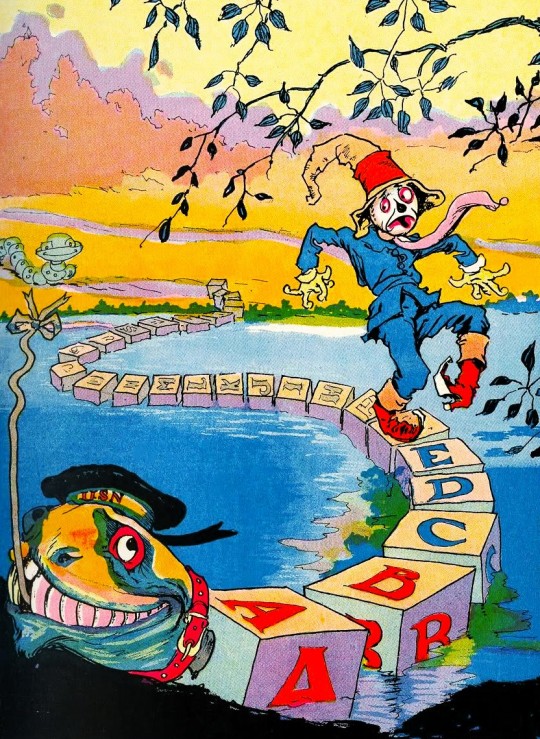
The Scarecrow and the A-B-Sea Serpent - The Royal Book of Oz, art by John R. Neill (1921)
#john r. neill#the royal book of oz#the wonderful wizard of oz#a-b-sea serpent#l. frank baum#ruth plumly thompson#the scarecrow#children's books#book illustrations#fantasy art#1920s#1921
521 notes
·
View notes
Text
The BFG by Roald Dahl (1982)
Captured by a giant! The BFG is no ordinary bone-crunching giant. He is far too nice and jumbly. It's lucky for Sophie that he is. Had she been carried off in the middle of the night by the Bloodbottler, the Fleshlumpeater, the Bonecruncher, or any of the other giants-rather than the BFG-she would have soon become breakfast.
When Sophie hears that they are flush-bunking off in England to swollomp a few nice little chiddlers, she decides she must stop them once and for all. And the BFG is going to help her!
Graceling Realm by Kristen Cashore (2008-2022)
Graceling tells the story of the vulnerable-yet-strong Katsa, who is smart and beautiful and lives in the Seven Kingdoms where selected people are born with a Grace, a special talent that can be anything at all. Katsa's Grace is killing. As the king's niece, she is forced to use her extreme skills as his brutal enforcer. Until the day she meets Prince Po, who is Graced with combat skills, and Katsa's life begins to change. She never expects to become Po's friend. She never expects to learn a new truth about her own Grace--or about a terrible secret that lies hidden far away . . . a secret that could destroy all seven kingdoms with words alone.
Oz by L. Frank Baum (1900-1920)
Join Dorothy and her little dog Toto on the yellow brick road, as they set off to explore the magical Land of Oz. Can they find the Wizard, defeat the Wicked Witch of the West, and return to Kansas?
Stardust by Neil Gaiman (1997)
Catch a fallen star . . .
Tristran Thorn promised to bring back a fallen star. So he sets out on a journey to fulfill the request of his beloved, the hauntingly beautiful Victoria Forester--and stumbles into the enchanted realm that lies beyond the wall of his English country town. Rich with adventure and magic, Stardust is one of master storyteller Neil Gaiman's most beloved tales, and the inspiration for the hit movie.
Inkworld by Cornelia Funke (2003-2023)
One cruel night, Meggie's father reads aloud from a book called INKHEART-- and an evil ruler escapes the boundaries of fiction and lands in their living room. Suddenly, Meggie is smack in the middle of the kind of adventure she has only read about in books. Meggie must learn to harness the magic that has conjured this nightmare. For only she can change the course of the story that has changed her life forever.
Ella Enchanted by Gail Carson Levine (1997)
At birth, Ella is inadvertently cursed by an imprudent young fairy named Lucinda, who bestows on her the "gift" of obedience. Anything anyone tells her to do, Ella must obey. Another girl might have been cowed by this affliction, but not feisty Ella: "Instead of making me docile, Lucinda's curse made a rebel of me. Or perhaps I was that way naturally." When her beloved mother dies, leaving her in the care of a mostly absent and avaricious father, and later, a loathsome stepmother and two treacherous stepsisters, Ella's life and well-being seem to be in grave peril. But her intelligence and saucy nature keep her in good stead as she sets out on a quest for freedom and self-discovery as she tries to track down Lucinda to undo the curse, fending off ogres, befriending elves, and falling in love with a prince along the way. Yes, there is a pumpkin coach, a glass slipper, and a happily ever after, but this is the most remarkable, delightful, and profound version of Cinderella you'll ever read.
The Witches by Roald Dahl (1983)
This is not a fairy-tale. This is about real witches. Real witches don't ride around on broomsticks. They don't even wear black cloaks and hats. They are vile, cunning, detestable creatures who disguise themselves as nice, ordinary ladies. So how can you tell when you're face to face with one? Well, if you don't know yet you'd better find out quickly-because there's nothing a witch loathes quite as much as children and she'll wield all kinds of terrifying powers to get rid of them.
The Kane Chronicles by Rick Riordan (2010-2012)
Since their mother's death, Carter and Sadie have become near strangers. While Sadie has lived with her grandparents in London, her brother has traveled the world with their father, the brilliant Egyptologist, Dr. Julius Kane. One night, Dr. Kane brings the siblings together for a "research experiment" at the British Museum, where he hopes to set things right for his family. Instead, he unleashes the Egyptian god Set, who banishes him to oblivion and forces the children to flee for their lives. Soon, Sadie and Carter discover that the gods of Egypt are waking, and the worst of them--Set?has his sights on the Kanes. To stop him, the siblings embark on a dangerous journey across the globe -- a quest that brings them ever closer to the truth about their family, and their links to a secret order that has existed since the time of the pharaohs.
Discworld by Terry Pratchett (1983-2015)
In the beginning there was… a turtle.
Somewhere on the frontier between thought and reality exists the Discworld, a parallel time and place which might sound and smell very much like our own, but which looks completely different.
Particularly as it’s carried through space on the back of a giant turtle.
It plays by different rules. But then, some things are the same everywhere. The Disc’s very existence is about to be threatened by a strange new blight: the world’s first tourist, upon whose survival rests the peace and prosperity of the land.
Unfortunately, the person charged with maintaining that survival in the face of robbers, mercenaries and, well, Death, is a spectacularly inept wizard…
Daughter of Smoke & Bone by Laini Taylor (2011-2014)
Around the world, black handprints are appearing on doorways, scorched there by winged strangers who have crept through a slit in the sky.
In a dark and dusty shop, a devil's supply of human teeth grown dangerously low.
And in the tangled lanes of Prague, a young art student is about to be caught up in a brutal otherwordly war.
Meet Karou. She fills her sketchbooks with monsters that may or may not be real; she's prone to disappearing on mysterious "errands"; she speaks many languages—not all of them human; and her bright blue hair actually grows out of her head that color. Who is she? That is the question that haunts her, and she's about to find out.
When one of the strangers—beautiful, haunted Akiva—fixes his fire-colored eyes on her in an alley in Marrakesh, the result is blood and starlight, secrets unveiled, and a star-crossed love whose roots drink deep of a violent past. But will Karou live to regret learning the truth about herself?
#best fantasy book#poll#the bfg#graceling realm#oz#stardust#inkworld#ella enchanted#the witches#the kane chronicles#discworld#daughter of smoke and bone
97 notes
·
View notes
Note
“I’m not sure Wizards of Oz is in the public domain.” L. Frank Baum’s original Oz novels were all published between 1900 and 1920, and are therefore in the public domain. The iconic 1939 film starring Judy Garland is still under copyright. You can make new adaptations of the Oz novels for free, but if you start borrowing elements introduced in the movie, it starts getting dicey (or expensive) fast.
FYI
66 notes
·
View notes
Text
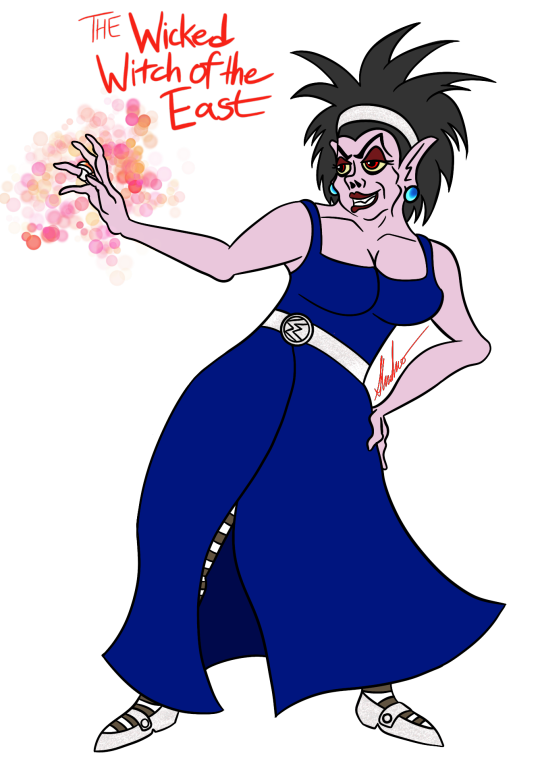
The Wicked Witch of the East
Unlike the Wicked Witch of the West, the Wicked Witch of the East doesn't really have an iconic image aside from a pair of colorful stockings and slippers that either silver or ruby.
Which means there's a lot more creative freedom to design her. Now I know that there are technically official artworks of the Witch of the East, but she all look like a generic old witch with a pointy hat and broomstick. One book from L. Frank Baum, The Tin Woodman of Oz, did mention that the Witch lived in a hut, implying for being the dictator of the Munchkins, her lifestyle was actually quite humble. And that's fine and all, but I feel like a witch who wears silver shoes or ruby slippers should be someone more vain. Someone who adores her looks despite being so old that she literally vaporize into dust upon death and contact with the sun's light.
And few Disney villains come to mind. Madame Medusa, Ursula, and of course, Yzma. I primarily used Yzma as the prime inspiration (you can see it with the pale blue skin and face) and even listen to her cut song Snuff Out the Light, particularly these lyrics:
Supai baby, turn me on
Every wrinkle soon be gone,
I could squeeze myself with glee the promises you made to me.
I've really stopped at nothing
Murder, treachery and lying
Whatever it takes to keep my looks
You really can't blame a girl for trying
Because I viewed her as a vain witch, I had her dressed in a rich blue dress that reminiscent of a 1920s dancer with wild 80s hair and a lot of makeup and dyed hair. Give her the iconic red and white stockings combined with silver decorations to match the shoes (except for a ruby on her ring, which acts as a source of power and a reference to the ruby slippers, and sapphire earrings), and you got yourself a campy, over-the-top tyrant that the Munchkins would be glad to see being squashed by a house.
Pose is from @adorkastock's Seriously casting a magic spell pose reference
#my art stuff#procreate#my art#land of oz#wizard of oz#oz series#oz#wicked witch#wicked witch of the east#the wizard of oz#yzma#ursula#procreate app#digital art#digital drawing#digital illustration#don bluth style#vanity#silver shoes#ruby slippers#wicked#munchkin
16 notes
·
View notes
Text
The Oz books by L. Frank Baum [3 of 3]
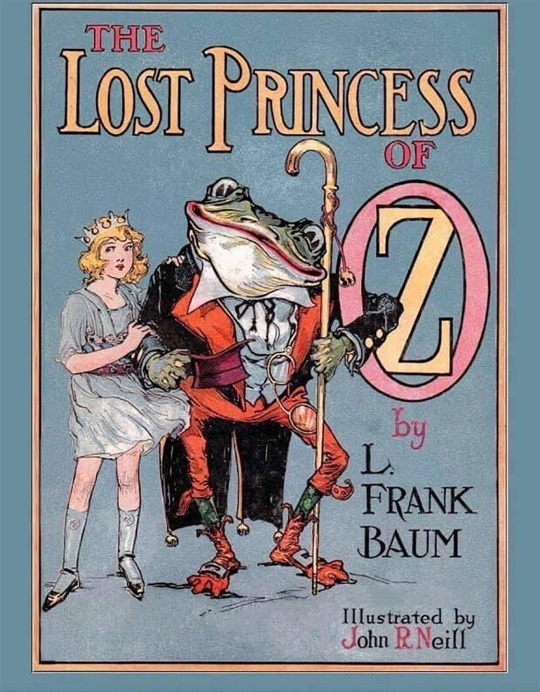
THE LOST PRINCESS OF OZ by L. Frank Baum (Chicago: Reilly & Britton, 1917) Illustrated by John R. Neill.
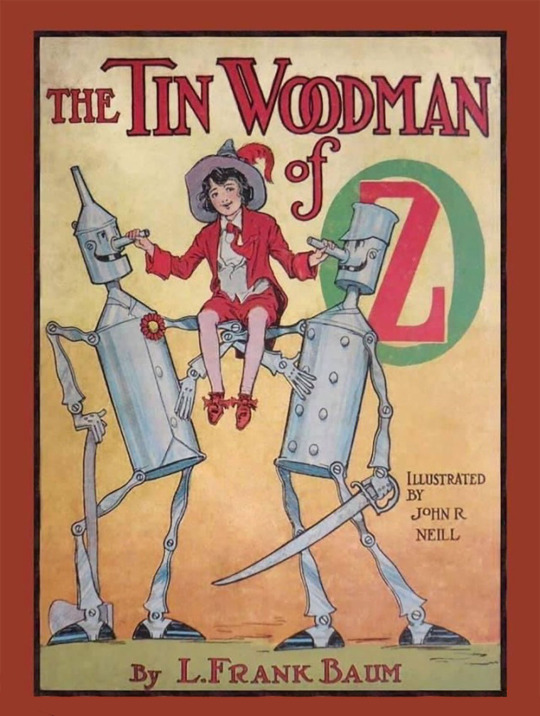
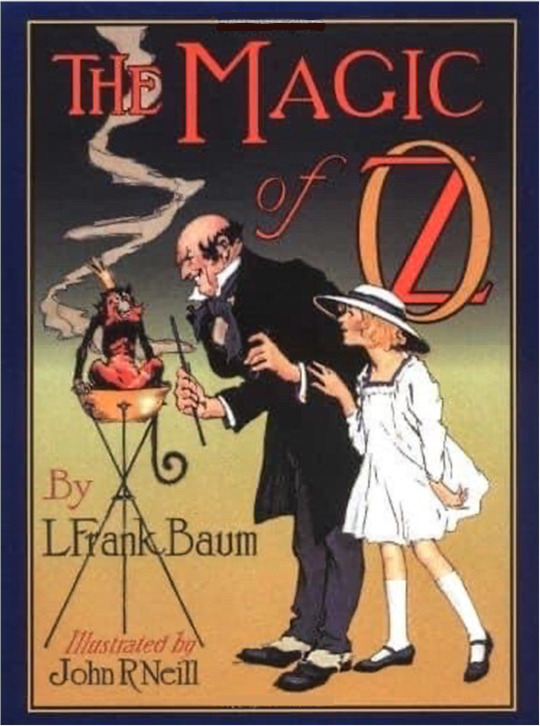
THE TIN WOODMAN OF OZ by L. Frank Baum (Chicago: Reilly & Lee, 1918) Illustrated by John R. Neill.
THE MAGIC OF OZ by L. Frank Baum (Chicago:Reilly & Lee, 1919) Illustrated by John R. Neill.

GLINDA OF OZ by L. Frank Baum (Chicago:Reilly & Lee, 1920) Illustrated by John R. Neill.
#book blog#books books books#books#book cover#pulp art#beautiful books#fantasy#wizard of oz#l frank baum#john r neill#book design
141 notes
·
View notes
Text
Princess Ozma
from the Wizard of Oz series by L. Frank Baum (1900-1920)



#for polls like this- vote by gender identity first regardless of sexuality. it's just too many options to have different combos of each#but you're encouraged to share your thoughts on both in the notes#princess ozma#wizard of oz#oz books#l. frank baum#classic literature#polls#queer#trans
13 notes
·
View notes
Text
So you want to know about Oz! (3)
Last time, we left on our sick and despaired mister Baum, as he realized he could never kill the child of his mind and despite his best efforts, the Oz fan would NEVER LET GO.
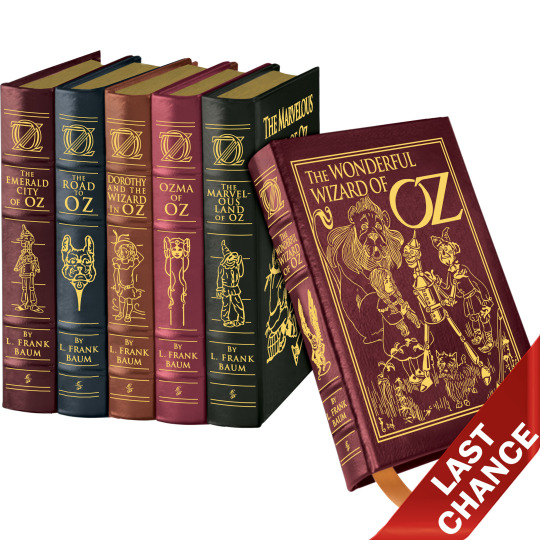
So, he decided "What the hell... If they want Oz books, they'll get Oz books!". And so he wrote more, and more, and more Oz books. At least, Baum understood that, in effect, people literaly did not care about any continuity. They were just interested in A) seeing old characters return and B) having more inventions and new lands thrown at them. They were all about that nostalgia and worldbuilding, without any care in the world for any cohesiveness or continuity error. So Baum gleefully invented and added as much as he could and went full whimsical-worldbuilding in what is truly a chaos to piece together when you try to look at Oz as a cohesive fantasy.
However that's the thing with Oz: it is not a cohesive fantasy series. The first two novels were not meant to be serialized or have sequels, as such, when he started doing them, Baum was forced to change things. It is as early as the fourth book, "Dorothy and the Wizard of Oz", which I like to call "BIG RETCON - the book" because it was Baum's first time at doing a huge lore retcon conflicting what was said in earlier books. Many people like to oppose in terms of worldbuilding Tolkien and C. S. Lewis - but I do believe Tolkien's archnemesis would be L. Frank Baum, with C.S. Lewis standing in the middle of the spectrum. Baum was just as prolific in content and enormous in scope as Tolkien when it came to worldbuilding... but when you put all things side by side it literaly makes no sense unless you look at the outside reasons that forced Baum to change his lore every three books or so. You know, it was a different time, fictional lore wasn't even a thing...
From six Oz books we went up to FOURTEEN Oz books in total. The man literaly kept writing them until his death... The last of the Oz books Baum wrote was "Glinda of Oz", published in 1920. L. Frank Baum died in 1919 from a stroke - he had finished the last Oz book, but it was only published posthumously... Yes, we can say the power of Oz was so strong it survived Baum...
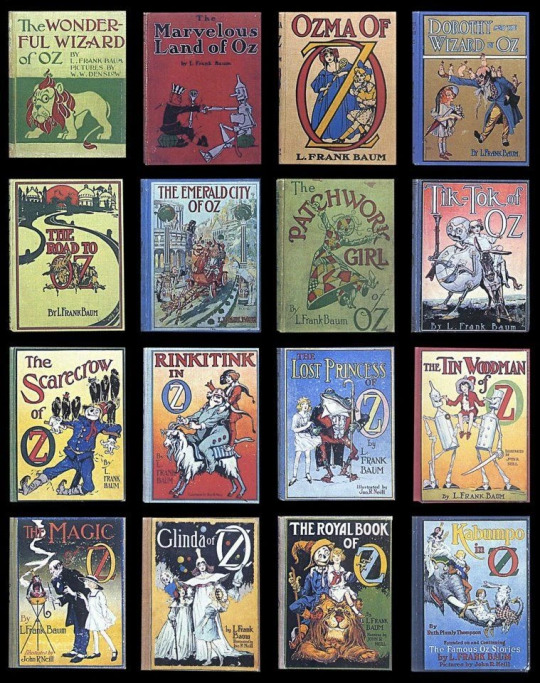
It actually DID survive though... In a way you might not expect.
There are many, many ways to "cut" the Oz book series. There is the "original trilogy". There is the "original six books". You can go with "the fourteen books Baum wrote". But for decades the dominating division went by an official title, used by both publishers and fan-circles around the USA... The Famous Forty.
Yes, you heard it right... Famous FORTY.
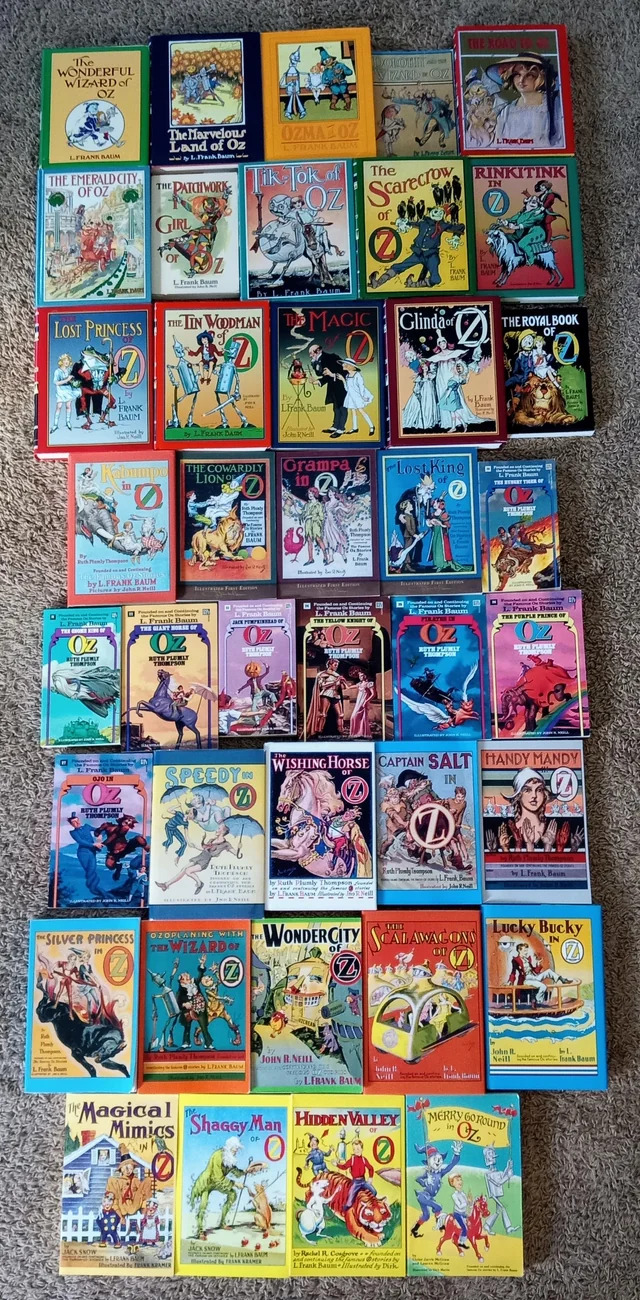
"But... but why are there FORTY Oz books if Baum only wrote FOURTEEN? It's a mistake in spelling right?"
No. There are FORTY Oz books that are considered "official" (I am not even getting in the non-official ones) by Oz canon. Well, only if you are not a purist who considers that only the books Baum wrote are Oz-canon and the rest are just fan-sequels (I am such a purist). It doesn't help that so far ONLY the books L. Frank Baum wrote are in public domain, the others are still under copyright law.
And why did we go from fourteen to fourty? Why... For money of course! It has always been the reason why Oz went beyond its original "stand-alone novel format". "Money makes the world go round" as the song says...
When Baum died, his publishers of the time, Reilly & Lee, started SWEATING. Because the Oz series was still their best-seller, their cash-cow, their sacred little idol... They couldn't JUST stop it there! They needed to have the series continue... And you know what they say in the editing world! "If you author dies... JUST REPLACE HIM!"
The idea of replacing Baum as the author of the Oz novel actually worked like a charm thanks to something Baum himself introduced... Baum, as the series was serialized, inserted himself as a character of Oz. More precisely he refused to present himself as an author or inventor, and when dealing with fan mail (literal mail, letters) or writing his prefaces, he presented hmself as "The Royal Historian of Oz". It was part of the fun game he had with children: he pretended the Oz novels were all official chronicles of what actually happened in Oz, and that it was his job to write them down. (That's also why he hoped the sixth book great finale of "Oz is cut off from the rest of the world" would work at killing the series, because "Oh well, I'm stuck in the USA, too bad I can't get in Oz anymore to write my... What? What did you say? THEY SEND RADIO BROADCASTS NOW?")
When it came time to replace Baum, the editors just went "Hey, so, a new Royal Historian was hired by the Crown of Oz! Don't worry, the chronicles of what is going on in this new land are still around!". That's how Ruth Plumly Thompson came in the picture.
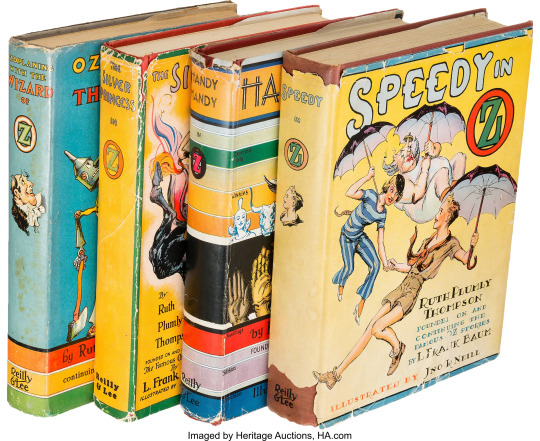
Now, I am not as knowledgeable on the other "Oz Royal Historians" as Baum. As I said, I am kind of a Baum purist. But here's some of the few things I know...
Ruth Plumly Thompson, the second "official Historian of Oz" by the editors' system was a huge fan of Baum's work, and so she jumped on the occasion to write more Oz books. (There were even rumors at some point that Thompson was Baum's niece and thus that the Oz books was just a family business). The Oz books were her main source of income, and so she worked VERY hard at doing Oz chronicles: she published one book each year.
Ruth Plumly Thompson's way of doing Oz was VERY different from Baum. I can't list all of the differences, but most notably Thompson' stories were closer to the traditional European fairytales, while Baum had always tried to subvert traditional fairytale tropes or avoid fairytale cliches at the time to truly do something new and fresh (him having a GOOD WITCH in the first Oz novel was a HUGE thing in the 1900s America where all witches were by default evil). Thompson also favored male protagonists (Baum always was fonder of female protagonists for Oz), and she introduced a lot of romances and love stories - something Baum was STRONGLY against, because in his aesthetic children did not care about romance and romantic love had nothing to do in youth literature.
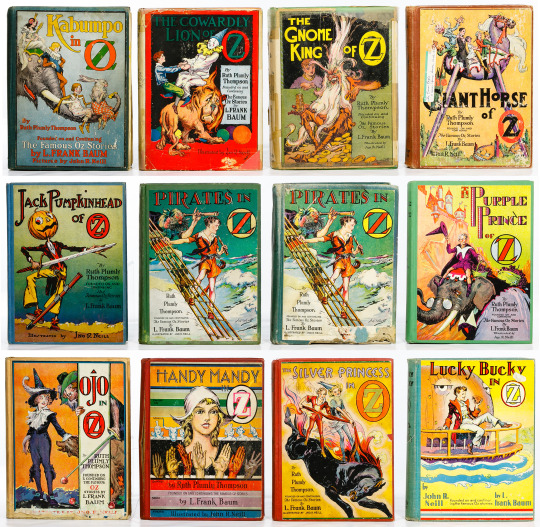
Thompson wrote 21 OZ BOOKS, yes, 21, from 1921 to 1976. Well, to be exact, she wrote 19 books in one swift series from 1921 to 1939, then took a long Oz pause, and wrote two additional Oz books in the 70s, but these two books are not considered part of the "Famous Forty". The last of these two was not even an Oz book originally but rewritten to fit an Oz novel - "The Enchanted Island of Oz", published the year of Thompson's death. [This tactic of taking a standalone fantasy novel for children, and reinventing it as an Oz book, had been used by Baum himself prior. His tenth Oz book, "Rinkitink in Oz", was originally its own thing, before he rewrote it as part of the Oz series, explaining why Oz only appears in the final chapters of this novel].
While most of these novels are just as forgotten, if not more obscure, than the many other Oz books Baum wrote, there is one element that tends to regularly pop up in Oz adaptations. Have you never wondered why the Good Witch of the North is sometimes called "Tattypoo"? (A name I personally HATE). The name appears for example in "The Muppets' Wizard of Oz", despite Baum never giving any name to the Witch of the North. Well, this was a Thompson invention! She was the one who named the Witch Tattypoo in her book "The Giant Horse of Oz", where she worked at giving a backstory to this character... a VERY divise backstory among Oz fans for many, many reasons too long to explain here.
Now, I said famous FORTY, and yet with Thompson's books added we only have 33 books.... What's the rest?
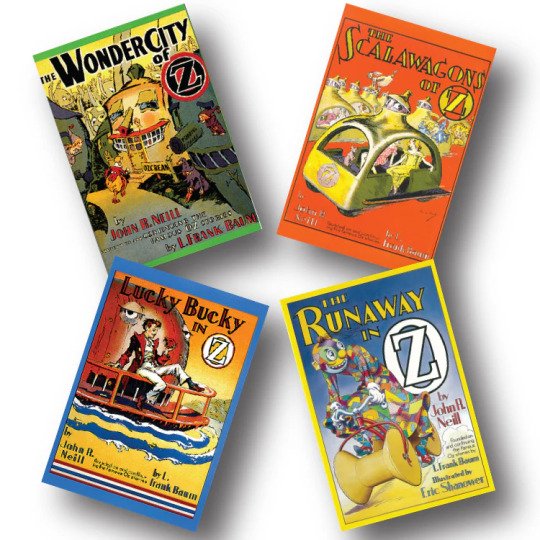
Three Oz books, "The Wonder City of Oz", "The Scalawagons of Oz" and "Lucky Bucky in Oz", were published in the early 1940s by John R. Neill, considered the third "Royal Historian of Oz". What is very interestng is that John R. Neill had worked on the Oz series for a very long time... since the very early Oz books in fact.
Everybody remembers the original illustrations for "The Wonderful Wizard of Oz" - these were done by an artist named W. W. Denslow. It was the art where Dorothy is this chubby little brunette girl. Well, you might be surprised to learn Denslow only worked on this Oz novel. When Baum wrote the sequel, "The Marvelous Land of Oz", Denslow did not return. Rather John R. Neill entered the picture. He would become the "official" artist of Oz, illustrating not only all of the Baum books (except the first one), but also all of the Thompson books. And while he originally tried to match Denslow's style to make a smooth transition for the child audience, he quickly grew his own style - he notably was the one who brought to us a tall, thin, blond and fashionable Dorothy that is a far cry from the more "proper farm girl" Dorothy of Denslow. In fact, Neill's work as an artist does show in the way he writes Oz, as he has very cartoony ideas and works heavily with the visuals, so that the text can allow for cool-looking illustrations.
Unfortunately, the Oz curse strikes again: Neill died in 1943, the very year following the publication of his third Oz book. There was a fourth Oz books in the plan, that he had written the manuscript of right before his death: "The Runaway in Oz". However, Reilly & Lee refused to publish the unfinished work... We would have to wait until 1995 for this book to finally see the light of day: kept by Neill's widow, it was finally published by the house Books of Wonders, in a format edited and illustrated by Eric Shanower (another prominent Oz artist which we will have to talk about later).
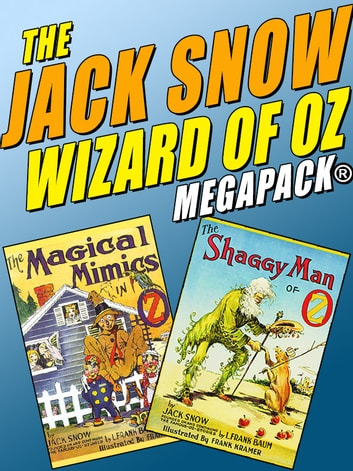
Outside of these three main Historians, three more were recognized by the editors. Jack Snow, who in the late 40s published two "official" Oz books, "The Magical Mimics in Oz" and "The Shaggy Man of Oz". He also created an "official guide" called "Who's Who in Oz", but which was noted to have some inconsistencies with the books (which is expected given the Oz series is INCONSISTENCY - THE SERIES). There are a lot of rumors around of a third, unpublished Oz book by Snow called "Over the Rainbow to Oz", but nothing allows us to confirm the existence of such a book.
Rachel R. Cosgrove published one "official" Oz book in 1951, "The Hidden Valley of Oz". She had prepared in 1954 a second Oz book, called "The Wicked Witch of Oz", but Reilly & Lee refused to have it publish because, at the time, "Oz books didn't sell" (CRAZY, right? Now, in the mid-50s, Oz books didn't sell anymore?). She still managed to have it published in the 1990s, by The International Wizard of Oz Club (another beast we'll have to talk about).
Finally, the last official "Royal Historian of Oz" was Eloise Jarvis McGraw, but she wrote her only official Oz book in collaboration with Lauren Lynn McGraw, her daughter. Their work was "Merry Go Round in Oz". They created another Oz novel, "The Forbidden Fountain in Oz", but while it was published it was not included in the "canon" Famous Forty, and in 2000 Eloise Jarvis McGraw published a third Oz novel alone, "The Rundelstone of Oz".

And thus you have it! The Famous Forty. The Forty books Reilly & Lee, the official publishers of the Oz books, deemed, edited and sold as the "canon" Oz books.
... But of course, this being Oz, and the Oz books entering public domain in the 50s, 60s and onward, the Famous Forty as far from the only Oz books to exist. Oh no...
On one side, you have The International Wizard of Oz Club, which I talked about previously. From the 50s onward they worked as the second main publishers of Oz books, since Reilly & Lee had stopped doing Oz novels on the accounts that "it doesn't sell anymore". It was the Club that published the last two Oz novels of Thompson, and the fourth unpublished novel of Neill, and the rejected novel of Cosgrove, and the second book of the McGraw duo, and many others! They published 8 Oz works in total from 1958 (Jack Snow's short story "A Murder in Oz") to 2006 (Gina Wickwar's Toto in Oz).
To that you can add three Oz novels that were recognized as "official" by the Baum Family Trust. Two were written by William Stout, "The Emerald Wand of Oz" (2005) and "Trouble Under Oz" (2006) ; the last was by Kim McFarland, "Sky Pirates over Oz" (2014)
And I am not even talking about the many books written by several descendants of L. Frank Baum! Two of Baum's sons attempted doing Oz books: Frank Joslyn Baum, the eldest ("The Laughing Dragon of Oz", 1934) and Kenneth Cage Baum, the youngest ("The Dinamonster of Oz", written in 1941 but only published in 1991). However the most prolific Baum-related author is without a doubt Roger S. Baum. Great-grandson of the original author, he wrote FOURTEEN Oz books, yes as much as his great-grandpa, starting with "Dorothy of Oz" in 1989, and ending with "The Oz Enigma" in 2013.
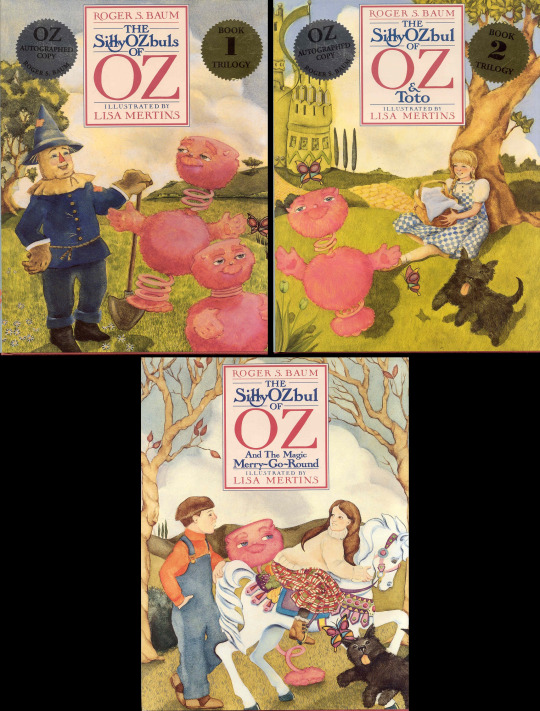
And ALL OF THAT is not even accounting for all the non-official Oz authors and their many, MANY books... Go check the Wikipedia pages for the list of Oz books, or the many pages of the Oz Wiki, you will be impressed.
I wasn't lying when I was saying there were Oz bookS in plural...
#oz#land of oz#l. frank baum#the famous forty#oz books#the wizard of oz#so you want to know about oz#ruth plumly thompson#john r. neill#royal historians of oz#jack snow#and there's many more but i am not going to tag them all#oz authors
47 notes
·
View notes
Text
broke: dark and gritty retellings of the wizard of oz (1939)
bespoke: dark and gritty retellings of the original l. frank baum books (1899-1920)
woke: any version that realizes the wizard himself is the true villain. the locked tomb series by tamsyn muir is the best dark and gritty oz retelling
21 notes
·
View notes
Text
85 YEARS AGO TODAY, ON AUGUST 25TH, 1939
In August 1939
Metro-Goldwyn Mayer Presents
1 Of The Greatest Musical 🎼 Fantasy Films 🎥 Of All Times
Based On The Children's Fantasy Novel Written By The Legendary L. Frank Baum
When a tornado rips through Kansas, Dorothy (Judy Garland) and her dog, Toto, are whisked away in their house to the magical land of Oz.
They follow the Yellow Brick Road toward the Emerald City to meet the Wizard, and en route they meet a Scarecrow (Ray Bolger) that needs a brain, a Tin Man (Jack Haley) missing a heart, and a Cowardly Lion (Bert Lahr) who wants courage.
The wizard asks the group to bring him the broom of the Wicked Witch of the West (Margaret Hamilton) to earn his help.
The 1956 television broadcast premiere of the film on CBS reintroduced the film to the public. According to the U.S. Library of Congress, it is the most seen film in movie history.
The film frequently ranks on critics' lists of the greatest films of all time and is the most commercially successful adaptation of Baum's work.
METRO-GOLDWYN MAYER PRESENTS
THE LEGENDARY & BELOVED ACTRESS OF THE 1920'S & 60's, JUDY GARLAND
IN
THE WIZARD 🧙♂️ OF OZ 👩🦰🐶🤡🤖🦁🧙♀️🧹🌪🎼✨
🎼WE'RE OFF TO SEE THE WIZARD 🧙♂️, THE WONDERFUL WIZARD OF OZ ✨
HAPPY 85TH ANNIVERSARY TO MGM'S
THE WIZARD 🧙♂️ OF OZ 👩🦰🐶🤡🤖🦁🧙♀️🧹🌪🎼✨








#TheWizardOfOz #DorothyGale #Toto #GlindaTheGoodWitch #Munchinks #ScareCrow #TheTinMan #TheCowardlyLion #TheWickedWitch #EmeraldCity #TheWizardOfOz #WereNotInKanasAnymore #TheresNoPlaceLikeHome #JudyGarland
#The Wizard Of Oz#Dororthy Gale#Toto#Glenda The Good Witch#ScareCrow#The Tin Man#The Cowardly Lion#The Wicked Witch#Emerald City#WereNotInKanasAnymore#There's No Place Like Home#Spotify#JudyGarland
2 notes
·
View notes
Note
Wha your an inspiration! Also sorry I meant to say what things will you see in your lifetime enter the public domain bsbsbhsbs should have said that! Anyways I'm happy to see the final stuff from the 1920s finally be layer to rest and enter the public domain by 2025! Also should more people be hyped and anticipated for the Steamboat Willie (1928) or The Opry House (1929) in your opinion/thoughts?
Anyways, what your top 15 most anticipated and hyped things whether it be cartoon/film, book or something else that will enter the public domain? Wah so sorry for so many questions dvbdbdd qwq
Things I'd like to see in my life time? well I did bring up a New Hope because I could live to see that enter the public Domain, I'd be in my 80s so it could happen. I'd love to see the end of the 95 year copyright, which would be the same year as Star Wars, in general I'd love for the law to change to something more reasonable because right now.... when the 95 year copyright term runs out we could be looking at works under copyright for well over 100 years, for example George Lucas is still alive if he died tomorrow by my math Empire would be under copyright till 2099, since he's a healthy (as far as I know) man in his late 70s he could live another 10 or 15 years (maybe even 20+) expending the term deep into the next century.
On Mickey Mouse, thats a tricky question. The Issue is the difference between Trademark and Copyright. Copyright is ownership of the whole idea in all contexts, while trademark is limited to images and words (or phrases) used for marketing. SO for example you could do a "Who Framed Roger Rabbit" style movie and have Mickey (and/or Minnie) show up. However Disney still holds/will hold the Trademark because those can be renewed endlessly, so you wouldn't be allowed to use his name in the title, or say his name in the trailers or any marketing. My question and I don't know is how much of the image do they own? could you use him in Steamboat Willie form? I would guess no, I think you'd be barred from using his image in marketing but I'd also guess you'd have a legal fight with Disney trying to use trademark as copyright.
in any case I think... there's a big big Disney community and I'd guess the first effect would be fan art and unofficial merchandise blowing up big time.
top 15? hmmm well I'll stick to stuff coming out in the near-ish future, I'm very unlikely under current laws to live to see Harry Potter become public, but that'd be a trip to see.
The Hobbit (1937): thankfully Elves and dwarfs were not made up by Tolkien so fantasy can basically steal his ideas freely but it's very clear we've all been playing in JRR's sandbox since at least The Lord of The Rings of not the Hobbit so releasing this out into the wild will be amazing also hobbits which he did make up (and also Ents, and the Uruk-hai) to finally be allowed to appear in all the fantasy literature that has elves and dwarfs.
The Wizard of Oz: Of course the original book by L. Frank Baum has been public for years and years and nothing stops any one from trying to make another one, and some have. See "The Wiz" and also "Wicked" but the 1939 movie remains a triumph and a huge piece of cultural history, I'm unsure what could be done with it, but you know
Superman, Batman, Robin, Wonder Woman, Captain America: I mean this should shock no one that this is something I want to see. But I think... Superman and Batman in particular are SUCH a universal part of our culture, you can stop randos on the street who have NEVER read a comic and say "what is Batman's name?" or Superman and they can answer, they can tell you Superman's powers. I think in terms of universally known and recognizable pieces of pop culture... I mean nothing else under copyright today is as big of a pop icon as they are they are as part of the basement of our popular imagination as Dracula, or Santa.
I'm sure a lot of other stuff but I think I've gone on long enough
4 notes
·
View notes
Text
Oz: What are the Famous Forty?
What are the « Famous Forty »?
Well, you must know by now that L. Frank Baum ended up writing fourteen Oz book, forming a series starting in 1900 and ending in 1920. The thing is, Reilly &Lee, the publishing house of Baum, knew very well how successful and popular the Oz series was, and refused to let it die with its creator. They hired new authors that became “Royal Oz Historians” and they were allowed to continue the Oz series – resulting in a total of forty “official” and “canon” book forming the full Oz series, as published by Reilly & Lee.
After Baum’s death, the publishing house put the Oz series in the care of Ruth Plumly Thompson. She ushered the second Oz era, by writing 19 Oz books, starting in 1921 and ending in 1939. Ruth Thompson style is quite different from the one of Baum: most notably, she tried to turn the Oz world into a more “classic fairytale” universe, by going a bit away from Baum’s innovations and novelties (for example, she turned the “Nomes” into “Gnomes”). Baum never had any male hero – Ruth had almost only male heroes. She was the one who introduced the most of the male protagonists of Oz, and she also had a greater focus on romance, weddings and royalty than Baum, a lot of her protagonists being princes and ending up married by the end of her novels. As a result, her books are quite controversial – for example, not everyone agrees with her decision to consider the Good Witch of the North’s old age a “curse” brought to her by enemies, that needs to be lifted so she can leave her job as the benevolent magic ruler of a region to become the pretty princess married to the kind of a city. But her presence in the Oz landscape stays very strong.
While she stopped participating in the Famous Forty in the 30s, she ended up releasing two more Oz books in the 70s: “Yankee in Oz” in 1972, and “The Enchanted Island of Oz” in 1976.
By this point, there were 33 Oz books.
The next official Oz historian was John R. Neill. He actually had participated in the Famous Forty before – he was the official Oz illustrator. He started illustrating the books with Baum’s “The Marvelous Land of Oz”, taking over from W. W. Denslow, and he ended up illustrating all of Baum’s and Thompson’s books. John Neill wrote three books for the Famous Forty, between 1940 and 1942: “The Wonder City of Oz”, “The Scalawagons of Oz” and “Lucky Bucky in Oz”. He actually had written a fourth Oz book for the Forty, but while he wrote it before his death he did not had time to illustrate it. The manuscript was however kept by his widow, and while not part of the Famous Forty, it was published in 1995, illustrated by Eric Shanower: “The Runaway in Oz”.
Neill’s take on Oz has been described as more… “manic”. Basically he had a children book illustrator’s mind when dealing with Oz, resulting in strong exaggerations – such as each quadrant of Oz being entirely of their associated color (from the sky to the skin color of people), or literally everything being alive in Oz, including houses.
After John Neill’s death, the next Oz Historian was Jack Snow. He was an avid fan of Baum’s writing as a child – in fact, when Baum died, Jack Snow offered to become the next Historian of Oz. It did not work, because he was only twelve years old at the time, but he ended up becoming the fourth Historian. He wrote two books for the Famous Forty: “The Magical Mimics of Oz” in 1946, and “The Shaggy Man of Oz” in 1949. It was rumored he had planned a third book, “Over the Rainbow to Oz”, but no manuscript was ever found. Snow wanted to return to a sort of Baum “fundamentalism”, by ignoring all the books of the previous Oz Historians and continuing right after Baum’s original books. Outside of his Oz writings, Snow was also a writer of ghost and horror stories for “Weird Tales”, and he notably produced a very daring short story – “A Murder in Oz”, trying to tie his two passions together by exploring the issue of the separate entities of Tip and Ozma. You must guess that the Oz editors refused to have such a story published, but it was eventually released by The Baum Bugle (the journal of the International Wizard of Oz Club, that started in 1957 and is still being published). Jack Snow also wrote “Who’s Who in Oz” in 1954, an extensive guide to all the characters in the Oz books. While the book was praised at the time and is still an important source of information, by now many have pointed several irregularities due to Jack Snow visibly misreading some of the characters (or simply losing track after reading 39 books in a row).
So, we are at a total of 38 books now. Only two were missing to form the Famous Forty.
The 39th book was written by Rachel R. Cosgrove: “The Hidden Valley of Oz”, released in 1951. She had written a second Oz book in 1954, “The Wicked Witch of Oz”, which tackled the issue of the missing Wicked Witch of the South, but she could not publish it, since Reilly & Lee considered the Oz books were not selling well anymore and wanted to close the series. The novel ended up however released by the International Wizard of Oz Club in 1993, illustrated by Eric Shanower. Rachel Cosgrove was notable for dismissing any kind of adult fan of Oz – she explained in the documentary “Oz: The American Fairyland” that she considered Oz to be a series for kids, that should not be enjoyed by adults.
The last book of the Famous Forty was “Merry Go Round in Oz”, released in 1963, and written by a collaboration: Eloise Jarvis McGraw and Lauren Lynn McGraw (mother and daughter). The two published another Oz book in 1980 (The Forbidden Fountain of Oz), while Eloise published on her own “The Rundelstone of Oz” in 2000.
There. These are the Famous Forty Oz book, the “complete official series”.
After that, the International Wizard of Oz Club published several books: as I mentioned they published the books of Ruth Thompson that were not included in the Famous Forty, as well as “The Forbidden Fountain” of the McGraw duo and “The Wicked Witch of Oz” of Rachel Cosgrove.
To these already mentioned book you can add “The Ozmapolitan of Oz”, a 1986 book by Dick Martin ; and two books by Gina Wickwar, “The Hidden Prince of Oz” in 2000 and “Toto of Oz” in 2006.
Finally, The L. Frank Baum Family Trust authorized an author named Sherwood Smith to publish new Oz books, declaring them officially canon. With this authorization, Smith wrote a trilogy between 2005 and 2014: “The Emerald Wand of Oz”, “Trouble Under Oz” and “Sky Pyrates Over Oz”.
These are all the books that could be considered “canon”.
Of course there’s always one more; the “orthodox sequels”. Books that try their best to be sequels or continuations of the official Oz books and their canon, but were not officially recognized as canon. There are several of them, starting in 1985 with James Howe’s “Mr. Tinker in Oz” and ending with “A Nightmare in Oz”, published in 2020 by David M. Keyes. A lot of them were made by members of Baum’s family, though there is a debate as to whether they should be considered “orthodox sequels” or rather “alternate Oz” books, but that’s for another time.
4 notes
·
View notes
Text
Excellent sleuthing.
1920 was also the year with Frank L Baum, the Oz author having passed away in 1919.
Mrs. Claus opens "The Year Without a Santa Claus" by claiming the eponymous year took place "before you were born". Seeing as the movie was released in 1974, this means the year must have been before then.
Bounding this on the lower end is the presence of ice hockey - mentioned by Heat Miser - and the use of telephones. Ice hockey was invented in 1875, while Alexander Graham Bell built the telephone in 1876, meaning the year must post-date these. These figures give a range of approximately 100 years during which Santa may have taken his holiday.

Yet, narrowing this further is the presence of a December calendar counting the 1st to a Wednesday. Between 1876 and 1974, only the Decembers of 1880, 1886, 1897, 1909, 1915, 1920, 1926, 1937, 1943, 1948, 1954, 1965, and 1971 started on a Wednesday.
But still this can be narrowed further.

When Santa set out that Christmas Eve, we see what appears to be an almost full Moon in the sky. Within the years listed, only 1920 had a full Moon on Christmas.
Ergo, 1920 was the year without a Santa Claus.
33K notes
·
View notes
Text
I suppose it would be good to post this here to raise awareness before my campaign begins.
W. W. Denslow was only the illustrator for the first Oz book, The Wonderful Wizard of Oz. John R. Niell was the illustrator for all of the rest of the original 14, plus for the continuation by Ruth Plumly Thompson, after Lyman Frank Baum's death in 1920. Those illustrations, when obtained from a non-copyrighted source such as Gutenberg.org, are in the public domain.
Those books that you buy or even obtain for free on Google Play, iTunes or Kindle are not necessarily a right source to obtain content in the public domain for use in your own works, because they may have copyrighted their publication of it. It really does matter where you get them from.
Content from L. Frank Baum's other non-Oz books, such as Queen Zixi of Ix, The Magical Monarch of Mo, The Sea Fairies, Sky Island, The Life and Adventures of Santa Claus, and John Dough and the Cherub are set in the same fictional universe and that content is also included in 5e Adventures in Oz.
Nonestica is the name of the fictional continent that contains all of these, including Oz.
List of Oz books - Wikipedia
1 note
·
View note
Text

“Glinda of Oz” by Baum
1920
Reilly & Lee - Chicago
Artist : John R. Neill
#l. frank baum#vintage illustration#children's books#children's illustration#children's literature#old illustration#old book#john r. neill#oz#glinda#glinda of oz#1920
190 notes
·
View notes
Photo

Photoplay, May 1925
#the wizard of oz#peter pan#larry semon#l. frank baum#l. frank baum jr.#j.m. barrie#herbert brenon#magazine: photoplay#year: 1925#decade: 1920s#type: fan mail#ph vol. 27 no. 6#\
11 notes
·
View notes
Text
the Scarecrow & the Tin Woodman
from the Wizard of Oz series by L. Frank Baum (1900-1920)

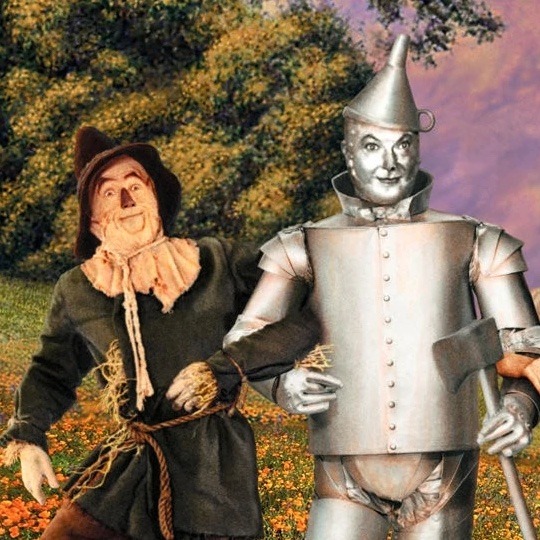

propaganda (quotes from the books) below the cut
The Marvelous Land of Oz:
"I shall return with my friend the Tin Woodman," said the stuffed one, seriously. "We have decided never to be parted in the future."
Little Wizard Stories - The Scarecrow and the Tin Woodman:
"There lived in the Land of Oz two queerly made men who were the best of friends. They were so much happier when they were together that they were seldom apart."
The Tin Woodman of Oz:
"Beside [the Tin Woodman], in a chair of woven straw, sat his best friend, the Scarecrow of Oz. At times they spoke to one another of curious things they had seen and strange adventures they had known since first they two had met and become comrades. But at times they were silent, for these things had been talked over many times between them, and they found themselves contented in merely being together."
The Tin Woodman does not love his fiancée but feels obliged to marry her: "I believe it is my duty to set out and find her. Surely it is not the girl's fault that I no longer love her, and so, if I can make her happy, it is proper that I should do so."
After discovering that his fiancée had married someone else, he gladly returns home with "his chosen comrade, the Scarecrow."
#“friends of dorothy”#this started as a bit of a joke but honestly I've convinced myself while finding these quotes#the wizard of oz#l frank baum#oz series#tin woodman#tinman#scarecrow#< turns out that's also a batman character. whatever#polls#queer#classic literature#new post
17 notes
·
View notes